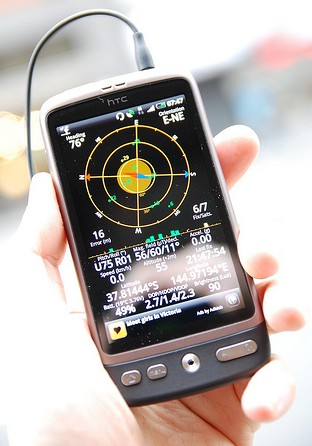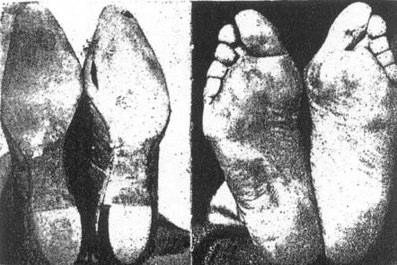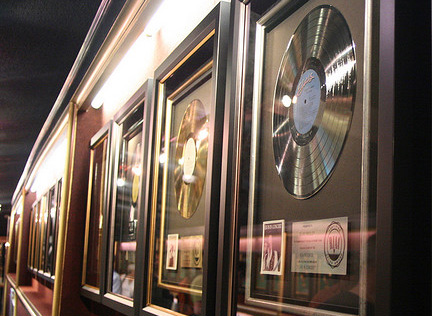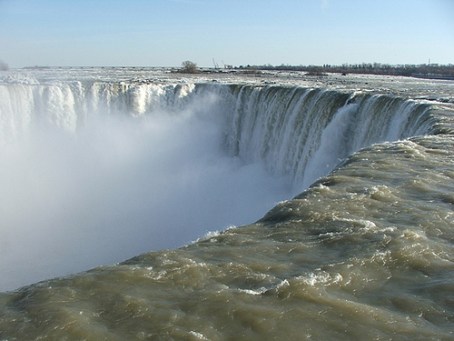Barefoot Running is Better for Joints Than Running in Shoes
By Chad Upton | Editor
Some people think these shoes look weird:
But, they just look like feet. So, maybe it’s our shoe stressed feet that look weird. If you look at your toes, they’re not spread out like your fingers. Most people’s toes are squished together in the shape of a shoe, even when they’re not in shoes.
That’s weird.
I never really thought about it much, until I saw a pair of these shoes. They’re called “Five Fingers” and they’re made by a company called Vibram. They’re a bit pricey, so you may also want to look at Fila’s similar and slightly cheaper version called “Skele-toes.” This style of footwear are to shoes what winter gloves are to mittens.
These shoes and the growing category of “minimalist running shoes” are a hot trend in running circles right now. There are many reasons why, but the ten most convincing reasons are on the floor in front of you.
We’ve been cramming our feet into unnatural shoes since childhood, but what would our feet look like if we had never worn shoes? Probably something like this:

These feet actually look weird too; we’re used to seeing feet that are shaped like shoes.
The difference is glaring. Look at the straight black line in the first photo, it stretches from the big toe, across the ball of the foot to the heel. You can’t draw a straight line on the second photo that aligns these three important parts of your feet.
 Cramping your foot’s style is not cool because that can lead to cramps and strains and lots of heel pains. If you’ve ever had foot pain or discomfort, you may think your shoes don’t have enough cushioning or that your arches have too much or too little support. While there are exceptions, these problems are generally myths perpetuated by the shoe industry that simply wants you to buy new shoes often.
Cramping your foot’s style is not cool because that can lead to cramps and strains and lots of heel pains. If you’ve ever had foot pain or discomfort, you may think your shoes don’t have enough cushioning or that your arches have too much or too little support. While there are exceptions, these problems are generally myths perpetuated by the shoe industry that simply wants you to buy new shoes often.
Many of the best runners in the world, who consistently win marathons, run without any shoes at all. Do they have bad feet? No, they have really strong feet. They also have better knees and hips than runners who use thick padded running shoes. One medical study compared running in shoes to barefoot and fount that barefoot running demonstrated 38% lower knee torque and 54% less internal hip rotation torque. This means that running barefoot provides a much more natural motion for your joints. This notion is pretty surprising the first time you hear it, but there are a mountain of medical studies to support it.
Should you throw away your super spongy running shoes and go barefoot tomorrow? Probably not. Just like running in shoes, you need some education to do it the best way possible. Check your area for a local running club where you can learn, or look for some online videos on the subject. I’ve also got some great sources listed below which would make a good starting point.
Also, running on soft shoes might not be a good idea but research shows that running on soft surfaces is better than hard surfaces. Even though grass and dirt may have rocks and pits, these actually work to strengthen your ankles over time. That said, you may also want to consider the type of floors you have at home — you may even want to get something like soft rubber floors.
PS – Neil posted a funny story at 1000awesomethings.com about my first outdoor run earlier this year.
Broken Secrets | Facebook | Twitter | Email | Kindle
Sources: PM&R, Shoe Myths, Nature.com, CMAJ.ca, bjsportmed.com
The Plastic End of a Shoelace is Called an Aglet
By Chad Upton | Editor
Originally and occasionally still, Aglets are made from metal, often copper or brass.
The word Aglet (or Aiglet) comes from an old french word, aguillette and it’s root word is aguille, which means needle. This makes sense since aglets make it easy to thread laces through eyelets in garments and shoes.

Metal aglets can still be found on garments, although usually as decorative accents rather than functional fasteners. Some of these decorative aglets are made from stone or glass and even shaped like small figurines. These go back to at least the fifteenth century, even Shakespeare references an “aglet baby” in The Taming of the Shrew.
Broken Secrets | Facebook | Twitter | Email | Kindle
Sources: wikipedia (aglet), dictionary.com
You May Have Helped Translate Books Without Knowing It
By Chad Upton | Editor
If you’ve created a website account with Facebook, TicketMaster, Twitter, CNN, Craigslist or thousands of other sites, then you have helped translate text from old books and newspapers.
Websites that offer free accounts try to ensure that every account is created by a real human being instead of a computer “bot” — computer programs written to automatically create accounts and then spam those websites with ads. One way to protect against bots is to have people do something that is easy for a human but difficult for a computer: read distorted text.

That’s why you are frequently asked to solve these simple word puzzles. Although it’s a bit annoying, it helps make the website better by reducing spam and other abuse. There are many variants of these puzzles, called captchas, and if the website uses the reCAPTCHA system, your work can also benefit society. (more…)
Some Fruit Seeds Contain Cyanide
By Chad Upton | Editor
Seeds from peaches, black cherries, apricots and apples contain a compound called amygdalin. Your body metabolizes amygdalin as hydrogen cyanide, which can make you very sick and even kill you (in large doses).
Hydrogen cyanide is lethal because it impedes blood from carrying oxygen, which is of course a critical function of blood.
The pits and seeds from cherries and apples aren’t a huge concern since it would take an unreasonably significant quantity of those to cause you harm. However, you should be more aware of the dangers of peach and apricot seeds if you like to eat them.
If you’re just consuming the fruit, there is nothing to worry about; however, some people buy bags of apricot seeds, or other forms of amygdalin, as a treatment or preventative treatment for cancer. It is marketed under the name Laetrile and “Vitamin B17” although there are many studies that prove it is not effective at treating cancer, not to mention the increased chance of cyanide poisoning.
A fatal dose of cyanide can be as little as 1.5 mg/kg of body weight. Since an apricot kernel contains approximately 0.5 mg of cyanide, consuming 150 seeds in a short period of time could be lethal to a 50 kg (110 lb) person.
It’s not just fruit seeds, there are other foods that contain cyanide too. Cassava, also known as tapioca, contains two forms of cyanide and should not be eaten raw. It is rendered safe for consumption by the process of soaking, cooking or fermentation.
There are many people who consume these foods in small doses without issue; you can buy bags of apricot kernels from Amazon or health food stores. If you do buy some, heed the serving suggestion and warning on the package.
Broken Secrets | Facebook | Twitter | Email | Kindle
Sources: wikipedia (amygdalin, cassava, cyanide poisoning, apricot kernel), Saint Louis University (PDF)
Guinness Beer Has Fewer Calories Than Skimmed Milk
Chad Upton | Editor
As much as I like to write about and consume coffee, beer is actually a more popular drink. Worldwide, Beer is the third most consumed beverage after water and tea.
It shouldn’t be too surprising, beer is the oldest known form of alcohol, thought to be over 10,000 years old. Trappist monks, and other religious people, originally brewed beer to help feed the community. Some dark beer, such as Guinness brand, is sometimes referred to as a “meal in glass.”
Although Guinness is dark, it’s pretty light on calories. A pint of Guinness only has 198 calories, less than skimmed milk, orange juice and most other non-light beers.
Thanks to Gord for submitting this one.
Broken Secrets | Facebook | Twitter | Email | Kindle
Image: Daniele Faieta (cc)
Sources: wikipedia (beer, guinness, trappist beer)
The New World Trade Center Remembers What We Lost
By Chad Upton | Editor
It has been ten years since the terrorist attacks on September 11th, 2001. Although the attacks happened in the United States, they were an attack on freedom everywhere. It is not an anniversary we want to remember, it’s an anniversary we never want to forget. That is the spirit on which the redevelopment of the World Trade Center is built.
When complete, the World Trade Center (WTC) will include a train station, performing arts center, retail space, five new office towers, a memorial site and museum. The tallest and most tributary building is Tower 1, nicknamed “The Freedom Tower.” That’s not a superficial name, the new tower embodies freedom and pays homage to the structures that came before it, a common device in architectural design.
The top floor of the new Tower 1 will reach 1,362 feet (415 meters), the same height as the former WTC South Tower. A glass enclosed observation deck will float just above that at 1,368 feet (417 meters), the same height as the original WTC North Tower. An illuminated antenna will reach further, bringing the total height to 1,776 feet (541 meters). The height is a significant symbol of freedom; 1776 being the year the US declared independence from Great Britain.
The antenna’s design draws inspiration from the torch on the nearby Statue of Liberty, a symbol of freedom itself. The blinking aircraft warning light at the top will blink in a slightly irregular pattern, repeating one long flash followed by one short flash. This is Morse code for the letter “N” for “New York.”
Aesthetics frequently differ among structures, but Tower 1 is unique on the inside too. Slated to open in late 2013, this 105 story building will feature a fortified structural base. Basically, the lowest 19 floors don’t contain any inhabitable space. Instead, they form a reinforced concrete pedestal intended to protect the building from ground based terrorist attacks similar to the truck bomb attack in 1993.
The rest of the building employs a redundant steel moment frame with an additional 3 feet (91 cm) thick reinforced concrete shear wall around the inner spine of the building. The core contains elevators, stairwells, electrical risers and sprinkler systems. These structural features and redundancies make it the strongest skyscraper ever built.
There are some additional safety considerations too. The building is situated 65 feet (20 m) away from the street, nearly triple the distance the twin towers were from the street. Additionally, the windows nearest the road will be made of a special blast-resistant plastic. The ventilation system contains biological and chemical filters and there are extra-wide emergency stairs exclusively for firefighter use.
There are seventy elevators, including some super high-speed elevators that travel at 33 feet per second (10 m/s). Some elevators are exclusively for emergency and non-ambulatory use. For safety, elevators will have their own backup power supplies and stairways will be pressurized to keep smoke from entering them.
Looking at the site plan, you may notice that WTC 6 is missing. WTC 1 is on the former site of WTC 6, so there will not be a new WTC 6. Although this plan calls for a WTC 5, the future of that tower is in question. The plans for WTC 5 were scrapped in 2008 when the major tenant pulled out in favor of another location in midtown manhattan. Tower 5 may get built, but there are no concrete plans at this time.
At the center of the site, a beautiful memorial has been created in the space that was once occupied by the twin towers. The memorial will be dedicated on September 11th, 2011 and be open to families who lost someone in the terrorist attacks. It will open to the public the following day.
Architects also designed the site so that every September 11th, between 8:46 am and 10:28 am (the time the first plane hit to the time the second tower collapsed), the alignment of the Earth and Sun will create a bright wedge shaped highlight that focuses light toward the memorial plaza.
The two footprints of the original towers will be represented by square shaped waterfalls, some of the largest man-made falls in the world. The names of nearly 3,000 victims of the 1993 and 2001 terrorist attacks will be memorialized in a bronze bezel that will surround the two square waterfalls. Over 400 trees have been brought in from around New York, Pennsylvania and Washington, DC, to honor those who died in the WTC, on Flight 93 and in the attack on the Pentagon. Among these trees, there is one that was actually on-site when the towers collapsed.
Known as the “Survivor tree,” this callery pear tree was burned by the fires and covered by the rubble when the towers collapsed. The tree was uncovered weeks later and taken to a nearby nursery. It was not expected to survive, but after tender care and pruning, it has grown 30 feet tall and returned to the World Trade Center site. While the waterfalls, and the names around them, represent what we lost, the survivor tree represents the courage, growth and perseverance that remains.
Broken Secrets | Facebook | Twitter | Email | Kindle
Images: Silverstein Properties (fair use), wikimedia commons (gnu)
Sources: Lower Manhattan Development Corporation, LowerManhattan.info, WTC.com, NYPost, 911 memorial, dna info, wikipedia (1 world trade, World Trade Center Site), popsci
Only One Plane Was Allowed to Fly After Flights Grounded on Sept 11th 2001
By Chad Upton | Editor
After the planes hit the twin towers on 9/11/2001, all commercial air traffic was grounded. But, a cross country flight was the only thing that could save one man’s life.
A couple hours after the terrorist attacks in New York and Washington, Lawrence Van Sertima, a snake handler of 40 years, was about to get his first snake bite. He was handling a Taipan snake, one of the most deadly in the world, when it became uncooperative and bit his thumb. He instantly knew he was in trouble.
Since air traffic was grounded, he could not be taken to the hospital by helicopter. It took 40 minutes to get to Miami’s Baptist Hospital by ambulance.
The venom from this particular snake attacks the blood, muscles, kidneys and heart. It’s one of the worst possible scenarios. Within hours he was in critical condition and soon bled from his eyes and mouth.
Miami-Dade’s Fire Rescue has a snake bite unit called “Venom 1.” They had 5 vials of a polyvalent antivenin, designed to treat multiple types of snake bites. It helped, and was barely keeping Van Sertima alive. He needed the monovalent antivenin, made from the venom of the Taipan snake, as soon as possible. Unfortunately, there were only two places that it existed: New York and San Diego.
The chances of getting clearance for a plane to take off from New York were unlikely, so they tried San Diego. The FAA in Washington granted permission for the flight, although it had to be escorted by two fighter jets. Within 45 minutes of landing, the antivenin was being administered.
Van Sertima recovered and learned about the terrorist attacks a few days later.
Bonus: Anti-venom and antivenin are the same thing.
Broken Secrets | Facebook | Twitter | Email | Kindle
Image: thefixer (cc)
Sources: discovery.com, jacksonville.com, clickorlando.com
Gold Record Awards Come From the Record Manufacturing Process
By Chad Upton | Editor
When a recording artist sells 500,000 units of an album or a single, their “record” is eligible for “gold certification” by the Recording Industry Association of America (RIAA). There are also platinum, diamond and other levels of these awards that indicate even greater sales.
If you couldn’t tell from the name, the RIAA is a US organization and it only tracks sales in the US. Similar awards are administered in 70 other countries by The International Federation of the Phonographic Industry, although the number of sales to achieve each award varies by country.
In 1958, the cast album from the production of Oklahoma! was the first album to receive the official gold record award. Back then, records were records. There were no CDs, MP3s, etc… albums were really only available on vinyl records. Magnetic tapes were not popular for consumer use and 8 Track cartridges were about six years away from creation.
To make vinyl records, an original “master” record is created and depending on the exact process used, the vinyl records are stamped from a master, mother or stamper record. In those days, these masters/mothers/stampers were generally made from metal. Stampers are used to literally stamp the groves into the records that are distributed. Stampers are generally good for about a thousand uses, so many stampers are produced for popular records. Originally, the used stampers were treated with gold to create the gold record awards.
Today, vinyl records are far from the most popular media for music, but some albums are available on vinyl. Although many albums are not available on vinyl, gold records may still be awarded if they reach their sales goals. The gold records are no longer made from actual records, masters or stampers. They’re now made by specific trophy and plaque makers who are certified by the RIAA.
Today, the award symbolically represents a high number of sales. But originally, it literally represented that many records were sold because the actual production stamper was worn out, gold plated and awarded to the artist.
In the last couple decades, the term “gold master” has transcended the recording industry. The phrase is also used in the computer industry to identify a software product version that is ready for distribution.
Broken Secrets | Facebook | Twitter | Email | Kindle
Image: Jim Cassady (cc)
Sources: RIAA, EIL, RecordPressing.com, Wikipedia (Gold Master), emusician
Niagara Falls Water Volume is Lower at Night
By Chad Upton | Editor
The magnificent waterfalls known as Niagara falls are split on the US/Canada border. People come to see massive amounts of water flowing over the falls and that’s exactly what they get, during the day.
While the falls are a popular tourist attraction, many people don’t know the water is an important source of power. There is one power company on each side of the border that draws water from above the falls to turn their generators.
Unfortunately, drawing water from the river above the falls can impact what the falls look like.
During the tourist season (April to October), the power companies must maintain the water flow over the falls at 100,000 cubic feet per second. That’s not very difficult since the river has a natural flow of about 212,000 cubic feet per second on a typical summer day. That means they normally draw about 100,000 cubic feet per second for power generation and allow that same amount over the falls.
But at night, they can draw even more water and lower the flow at the falls to about 50,000 cubic feet per second. This extra flow allows them to turn their turbines and fill up their reservoirs so they have more water after the tourism flow is restored in the morning. Since the falls erode about two feet per year, drawing extra water at night also slows erosion so the falls will be around for many generations to come.
Broken Secrets | Facebook | Twitter | Email | Kindle
Image: Alberto Mari (cc)
Source: NiagaraFrontier.com
Your GPS Will Disable Itself If It’s Going Too Fast
By Chad Upton | Editor
 Whether it’s your windshield mounted Garmin or your pocket slung smartphone, your GPS device is programmed to disable itself under certain conditions.
Whether it’s your windshield mounted Garmin or your pocket slung smartphone, your GPS device is programmed to disable itself under certain conditions.
If it’s travelling faster than 1200 MPH or above 65,000 feet in altitude, the GPS function will shutdown.
These restrictions were put in place to help ensure the technology could not be used for malicious intentions by foreign governments or terrorists.
Modern commercial airplanes do not typically approach this speed or altitude, so you can’t test this unless you build your own missile or weather balloon.
Broken Secrets | Facebook | Twitter | Email | Kindle
Photo: avlxyz (cc)













